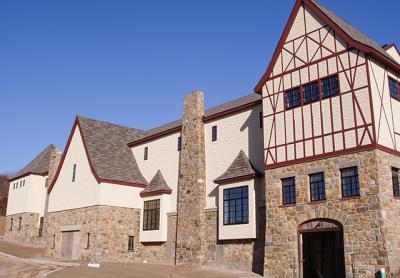Playhouse Asks Town for $3 Million for Pool, Arts

Members of the Montauk Playhouse Community Foundation, working to begin what has been planned from the start as the second phase of the reconstruction of the 1927 Tudor-style building, have turned to East Hampton Town for help, hoping it will invest $3 million to boost the $8.5 million project to completion.
With the proceeds of a $6 million bond issued by East Hampton Town in 2003, the foundation created a gymnasium, fitness center, and spaces for adult and child day-care programs, which have been operating since 2006.
A large indoor space was left undeveloped for phase two, designed to include an aquatic center and a cultural arts center.
The foundation has $2.5 million in donations in the bank and another $500,000 expected. If the town provides $3 million, Susan Henkin, the executive director of the playhouse, told the town board at a meeting in Montauk on Tuesday, it would be easy to raise the additional $2.5 million needed. A number of donors have promised additional donations when the project gets closer to its goal, she said, adding that the remainder of the money could be raised “in very short order.”
“People are waiting in the wings to contribute, but want to see tangible progress,” said Perry B. (Chip) Duryea III, a playhouse foundation board member. “When that shovel goes in the ground a lot of good things will happen.” Encouraging the town’s participation, he said, “This is a project that needs to get done, and it needs to get done soon.” With the aquatics and cultural centers completed, Mr. Duryea said, the playhouse would be a magnet and a “tremendous plus for the community, on many levels.”
According to a business plan developed by the foundation board, the aquatic and cultural centers are to be self-sustaining, with revenues from memberships, admission to events, and rentals of the space.
The aquatic center is to have two pools, for lap swimming and for recreation. The cultural center would include flexible, multi-use spaces that could accommodate conferences, events, meetings, and performances, and an entrance lobby that could be used for gatherings and exhibits.
The building, which is on the National Register of Historic Places, was constructed by Carl Fisher as a tennis stadium and is on the Preservation League of New York State’s “Seven to Save” list.
It was taken over by the Navy during World War II, then converted for use as a summer theater. It was also used for indoor riding by the Montauk Horsemen’s Association and as a movie theater before being closed in the 1970s. After several failed attempts to develop the site for affordable housing and apartments for senior citizens, Joseph Oppenheimer, the building’s owner, donated it to East Hampton Town in 1999.
Town Supervisor Larry Cantwell said the previous town board’s decision to save and renovate the playhouse had been a good one. “A significant investment was made by the town at that time,” he said, and “it turned out to be a wonderful asset. We’re kind of at a crossroads again in terms of completing a vision,” he said.
Should the town board decide to modify the capital budget for 2018 or 2019 to include money for the playhouse, bonds would be issued and the completion of phase two would become a joint project, with municipal procedures to be followed, he said.
--
Correction: An earlier version of this article incorrectly stated that the Playhouse Foundation has $250,000 in donations in the bank. In fact, it has $2.5 million in donations in the bank.
